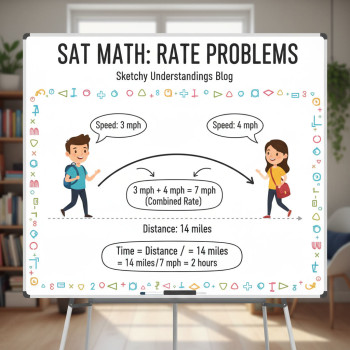Why Precision Wins on the SAT: A Friendly Primer
Walk into the SAT Writing & Language section expecting poetry and you’ll leave a little confused. The test isn’t asking you to show off your most inventive metaphors or your flair for unexpected sentence structures. Instead, it rewards a different kind of skill: precision. That means clarity, grammatical correctness, concision, and a predictable logic to how ideas are ordered and connected.
If you’re a student who loves creative expression, this can feel like a disappointment. But think of it another way: the SAT tests how well you make meaning clear for the broadest possible audience under time pressure. That is an enormously useful skill—especially in college essays, lab reports, and real-world communication. This post explains why precision matters on the SAT Writing section, gives practical examples and strategies, and shows how to practice effectively (including ways Sparkl’s personalized tutoring can help if you want tailored guidance).
What the SAT Writing & Language Section Actually Tests
Before arguing for precision, let’s be clear about what the section covers. The Writing & Language portion focuses on:
- Standard English conventions: grammar, punctuation, verb tense, subject-verb agreement.
- Effective expression: concision, word choice, and sentence clarity.
- Rhetorical skills: organization, development, and the logical flow of ideas.
- Editing for clarity and tone appropriate to the passage.
These items are not subjective art-judgments. Each question has an objectively best answer according to conventions and the passage’s intended meaning. That’s why precision—not creative license—earns points.
Precision vs Creativity: Core Differences
Let’s compare the two in simple terms:
- Precision is about being unambiguous, efficient, and correct. It prioritizes the reader’s immediate understanding.
- Creativity is about novelty, voice, and stylistic risk. It prioritizes artistic expression and surprise.
On the SAT, the test makers assume a neutral, academic voice and reward answers that make the intended idea clear with minimal friction. Creativity can be wonderful in a poem or a narrative essay, but on a multiple-choice, time-pressured editing test it often introduces ambiguity or nonstandard constructions that the test will penalize.
Comparison Table: Precision vs Creativity (On the SAT)
| Feature | Precision (SAT-Preferred) | Creativity (Often Penalized) |
|---|---|---|
| Clarity | Direct, explicit meaning | Ambiguous, layered meaning |
| Word choice | Conventional, unambiguous words | Uncommon or figurative words |
| Sentence structure | Standard grammar and parallelism | Fragments, inverted order, complex rhythm |
| Punctuation | Correct, purposeful punctuation | Experimental or rhetorical punctuation |
| Goal | Convey precise information | Create emotional or aesthetic effect |
Why Precision Scores Better: Four Practical Reasons
Understanding these concrete reasons will help you stop seeing the SAT as an enemy of creativity and start seeing it as a test of a specific, useful skill.
1. Multiple-choice demands unambiguous answers
Each question gives exactly four options with a single best choice. Creativity often produces an appealing but subjective alternative. On the SAT, the best answer is the one that makes the passage clear for all readers—not the answer that sounds most interesting to a single reader. Precision avoids subjective traps.
2. Conventions exist to reduce misunderstandings
Grammar and punctuation are communal tools. They exist so a writer’s meaning can be reproduced reliably. When the test asks you to fix a comma splice or pronoun reference, it’s rewarding your ability to make meaning reliably communicable—precisely the skill standardized testing measures.
3. Time pressure rewards short, decisive edits
Because you have limited time, you benefit from knowing patterns: subject-verb agreement, misplaced modifiers, parallel structure. Those patterns let you identify correct answers quickly. Creative constructions that break patterns can slow you down as you think, Is this allowed here? Is the test expecting this exception? Precision buys time.
4. Rhetorical choices on the SAT still prefer clarity
While the test does assess higher-level rhetorical choices—tone, transitions, sentence order—it does so through the lens of clarity. Choose the option that improves coherence and supports the paragraph’s purpose. Sometimes that means combining sentences or tightening wording—classic precision moves.
Common Precision Pitfalls and How to Fix Them
Here are typical traps students fall into when creativity interferes, with simple fixes you can apply on test day.
Misdirected modifiers
Creative writers sometimes place descriptive phrases for stylistic effect. On the SAT a misplaced modifier can change meaning. Fix: attach the modifier to the closest logical word.
Example:
- Problem: Walking to the bus stop, the cold air made Maria shiver.
- Why it’s wrong: The sentence implies the cold air was walking.
- Fix (precise): Walking to the bus stop, Maria shivered in the cold air.
Loose pronoun references
Using ‘it’, ‘they’, or ‘which’ creatively can leave readers guessing. Fix: make the antecedent explicit.
Example:
- Problem: The scientists reported their findings to the board, which surprised everyone.
- Why it’s wrong: Does ‘which’ refer to the findings or the report?
- Fix (precise): The scientists reported their findings to the board, and the presentation surprised everyone.
Overly elaborate punctuation
Em dashes and parentheses can be stylish, but they also create interruptions that may obscure the main clause. Fix: tighten punctuation and ensure the main idea is clear.
Example:
- Problem: The study—despite its small sample, and its limited scope—suggested a surprising trend.
- Fix (precise): Despite its small sample and limited scope, the study suggested a surprising trend.
Strategies to Train Precision (Not Creativity) — Practically
Precision is a skill you can practice deliberately. Here are techniques that help you think like the SAT writer and grader.
1. Learn high-frequency grammar patterns
Memorize and practice patterns that the test loves: subject-verb agreement, parallel construction, pronoun-antecedent clarity, comma usage with independent clauses, semicolon basics, and correct use of modifiers. When these patterns become automatic, you can spot errors quickly.
2. Read with the editor’s eye
When you read a passage, ask: What’s the main point of this paragraph? Which sentence supports it directly? An editor trims anything that does not strengthen the paragraph’s main function. Practicing that mindset trains you to prefer precision over flourish.
3. Practice concision
The SAT often prefers shorter, cleaner phrasing. Practice rewriting wordy sentences in a more concise form without losing meaning. This is one area where creative verbosity will hurt you—brevity and clarity win.
4. Time-box your review
Simulate test conditions: 35 minutes for 44 questions. Learn to make quick calls. If a question takes more than 60–90 seconds, flag it and move on. Precision thinking helps you make those quick, defensible calls.
Sample Practice Walkthrough: Spot the Precision Move
Work through this example as you would on test day. Read the short paragraph and then choose the most precise revision for the underlined portion.
Passage excerpt (edited for this example): “The committee had to decide whether to fund the project, despite the fact that its outcomes were uncertain and there was little evidence to support the predictions made by members who were enthusiastic.”
- Option A: No change.
- Option B: The committee had to decide whether to fund the project, despite uncertain outcomes and little supporting evidence for members’ predictions.
- Option C: The committee had to decide whether to fund the project, despite the fact that its outcomes were uncertain and little evidence was available to support the predictions made by members who were enthusiastic.
- Option D: The committee had to decide whether to fund the project, although the outcomes were uncertain and there was little evidence supporting the predictions of enthusiastic members.
Analysis:
- Option A keeps wordy phrasing: “despite the fact that” is clunky.
- Option B creates a slight ambiguity: “for members’ predictions” could be interpreted as evidence supporting members, not members’ predictions.
- Option C is wordy and repetitive.
- Option D tightens the sentence and clarifies the relationship: “although” is concise and “predictions of enthusiastic members” links the idea cleanly.
Best answer: D. It demonstrates precision by cutting redundancy and sharpening meaning.
Practice Plan Table: 6-Week Precision Bootcamp
| Week | Focus | Daily Goal (30–45 min) |
|---|---|---|
| 1 | Grammar fundamentals | Drill subject-verb agreement, pronouns, and verb tense |
| 2 | Modifiers and clarity | Practice spotting misplaced modifiers and fixing sentences |
| 3 | Conciseness and wordiness | Rewrite passages to be more concise while preserving meaning |
| 4 | Rhetorical skills | Work on sentence order, transitions, and paragraph purpose |
| 5 | Mixed timed practice | Do full sections under timed conditions, review mistakes |
| 6 | Refinement and review | Targeted practice on recurring weak areas and strategy review |
When Creativity Helps (and When It Hurts)
Let’s be fair: creativity is not the enemy. In certain SAT-adjacent scenarios, a creative touch is useful, but it must be deployed where the test allows room:
- College essays and personal statements: Here, creativity and voice matter a lot. The SAT test measures different skills.
- Recognizing rhetorical effect: The test sometimes asks what tone or effect a sentence creates. Creativity in understanding tone helps you choose the clearest option.
- Finding elegant concise rewrites: Creativity can help you compress long ideas into a tight sentence—an art that combines precision and style.
Creativity hurts when it leads to nonstandard punctuation, ambiguous antecedents, or unusual word order that obscures meaning. The rule of thumb: save artistic risks for places that reward them; use precision for the SAT Writing & Language section.
How Sparkl’s Personalized Tutoring Fits Naturally Into Precision Training
If you’ve read this far, you might want support making precision second nature. That’s where one-on-one coaching can be transformational. Sparkl’s personalized tutoring offers tailored study plans that focus on your specific error patterns—so if misplaced modifiers or pronoun ambiguity are your kryptonite, your practice will target those exact skills. Expert tutors walk you through explanations, provide immediate feedback, and the program’s AI-driven insights can highlight recurring mistakes across practice tests.
What makes this effective is the combination of human expertise and targeted practice: tutors model the editor’s eye, give real-time corrections, and help you build quick heuristics so you can make precise calls under time pressure. That targeted approach is often faster and more motivating than trying to fix everything at once.
Test-Day Habits to Maximize Precision
On the test, your best friends are calm pacing and pattern recognition. Here are practical habits to use on exam day:
- Skim the passage first: Identify the main idea of each paragraph before tackling questions tied to tone or structure.
- Eliminate obviously wrong choices quickly: Often two choices can be tossed because they introduce grammatical errors or change meaning.
- Favor clarity and concision: If two choices are grammatically correct, choose the one that is clearer and more direct.
- Keep an eye on transitions: Words like however, therefore, and moreover change relationships between clauses—pick the one that matches the paragraph’s logic.
- Flag and return: If you’re unsure, mark it. Precision thinking often becomes easier after seeing neighboring questions or rereading the passage.
Quick Decision Heuristics
- Pronoun = explicit antecedent.
- Comma + fanboys = two independent clauses. If you don’t have two independent clauses, you probably need something else.
- Modifier = attach to closest sensible word.
- Parallelism = always check lists and comparisons for matched structure.
Wrapping Up: Precision as a Transferable Skill
If you study for precision, you aren’t just gaming a standardized test—you’re training how to think clearly and communicate efficiently. Employers, professors, and peers reward that. On the SAT Writing & Language section, precision has measurable payoff because the test’s design rewards correctness and clarity over novelty.
So if you love creative writing, keep doing it—crafting voice and surprise builds imagination. But when you sit for the SAT Writing & Language section, put your editor’s hat on. Learn the high-frequency patterns, practice under time, and adopt the mindset of making meaning instantly accessible to the widest possible audience. If that process feels overwhelming, consider targeted support: Sparkl’s personalized tutoring can give you one-on-one guidance, a tailored study plan, and AI-driven insights to accelerate your progress.
Final Thought
Precision is not small-minded; it’s disciplined creativity. It’s the skill of choosing the best words and structure so your idea lands exactly where you want it to. Master that on the SAT and you’ll walk away with a better score—and a stronger ability to communicate clearly in college and beyond.

















No Comments
Leave a comment Cancel